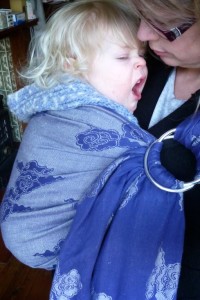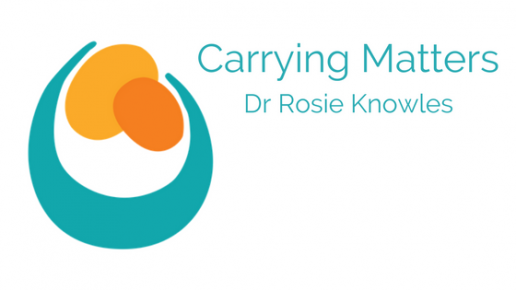Sleeping while your baby is sleeping in a sling – is this safe?
Imagine the scenario, familiar to all of us…. you are a very tired parent, with a new baby who doesn’t seem able to settle down in their Moses basket or cot, and will only sleep when held and rocked. Your baby cries when he is laid down again, no matter how deeply he seemed to be asleep on your chest or your partner’s shoulder just a moment ago. This is where you might turn to a baby carrier (typically a stretchy wrap, or a ring sling, sometimes a buckle carrier or a meh dai), which keeps your baby close, in the supported position she loves, able to hear your heartbeat and breathing, everything smells right, it is warm, she is surrounded snugly with gentle pressure all over and not flailing freely in open space. (See here for more information on the “fourth trimester” theory of meeting baby’s needs.)
So far so good, your baby is positioned well in the sling, airway is protected, breathing is unobstructed, spine and head are well aligned with a supported upper back and a gentle curve into a tilted pelvis. You can see that your baby’s face is visible and he is close enough to kiss, there is no slumping, your rocking movements (swaying, walking) and precious closeness and feeling safe in your arms has worked its magic, and your baby is at last, peacefully and contentedly asleep.

At this point, I remember it well, the relief is enormous. The temptation is very, very strong, to just sit down in a cosy armchair and close your eyes, or a have a little lie down on the bed well propped up with pillows. Soon sleep starts to overwhelm you. Just a a short nap.. a few minutes won’t hurt, surely, a chance to recharge my batteries for the next parenting challenge.. sleep is so restorative!
The trouble is, one of the central tenets of safe babywearing is to be aware of your baby at all times.
- The TICKS rules and the ABC guidelines are all aimed at protecting your baby’s airway and breathing, and the only way you can monitor this is by being alert.
- It doesn’t take long for a baby’s breathing to become compromised, and the risk is greatest under four months, when their heads are disproportionately large and heavy and they have not yet developed the cervical stability needed to support themselves.This takes time – the vertebral bodies need to become strong enough to support the head, then the joints, ligaments, muscles, tendons and other soft tissues in the neck need to develop the required strength, and then the back muscles need to be strong enough to pull the heavy head backwards to avoid forwards or sideways slump. This is an active process, and it is easy for a sleeping baby’s head to roll forwards onto their chest. This is why head support is so vital, and why a baby’s face must be visible at all times.
- This is the same reason why children should not sleep in car seats if possible. We’ve all seen children with their heads hanging forwards at awkward angles. Studies have shown that this forward lolling of the head can cause desaturation (reduced levels of oxygen in the blood). In contrast, another study has shown that a baby asleep in the optimal upright position with chin up and the head well supported on parent’s chest does not show such desaturations. It is safe for a baby to sleep upright in a well fitting and supportive sling if the appropriate guidelines are followed.
- It is also is why bag slings and near-horizontal cradle carries can cause such problems. The enclosing fabric behind the head is dangerous; Babies have heavy heads, more prominent occiputs, and do not yet have the strength to pull their heads up or push against the fabric. The chin ends up resting on their the chest, causing a potential airway compromise.
- It is also why feeding in a sling needs to be undertaken with caution and a good understanding of safety.
- It is why there are so many guidelines about safe sleeping while responsible for a child (whether or not you are using a sling).
A sleeping parent will not be able to check their baby’s position often, and correct any breathing difficulties quickly. Grunting or snoring or other unusual noises should always prompt a check on your baby’s position and it will be very hard to be aware of such changes while you are almost, or fully asleep.
Your body position will change as your muscles relax in sleep. Your arms may move if you are just holding your baby, and if baby is in a sling, it may no longer remain tight and supportive, possibly allowing him to slump over or curl up into a ball with his chin on his chest, or roll to one side. We’ve all seen this with babies in car seats. You yourself may roll over as you relax and unwittingly place too much pressure on parts of your baby’s body, or encourage him to roll with you.
In short, while you are asleep, you are unaware of what you or your baby are doing. This is why there are so many guidelines about providing a safe sleeping environment for babies, keeping them safe when there is nobody awake.
If you have had something alcoholic to drink, are a smoker, are on medications that could make you drowsy, or have a medical condition that could impair your ability to be aware of your child at all times, you may wish to reconsider how you are caring for your baby when you are tired.
There are of course some ways that a short nap could be done safely with your baby asleep in your arms or in a carrier. For example, if your partner remains in the room with you and alert while you and baby enjoy a rest together, in a slightly-reclined, well supported position that ensures baby is still upright. You may be in hospital with your premature baby and are encouraged to share skin-to-skin contact inside a simple stretchy wrap or boob tube or under a blanket. You and your baby will be very closely monitored throughout if you do nod off in the chair (which often recline at special angles to make it easy for a baby to rest on their tummies, chest to chest with heads well supported.)
If you wish to sleep with your baby close to you, with or without a sling, all the principles for safe co-sleeping apply. The links below explain safe bed-sharing very well.
KellyMom summary – http://kellymom.com/parenting/nighttime/cosleeping/
Mother-Baby Behavioural Sleep Laboratory – http://cosleeping.nd.edu/safe-co-sleeping-guidelines/
BASIS Online – https://www.dur.ac.uk/resources/isis.online/pdfs/ISISPDFbed-sharingJuly2013.pdf
UNICEF Caring For Your Baby at Night http://www.unicef.org.uk/Documents/Baby_Friendly/Leaflets/caringatnight_web.pdf
If you feel at the end of your tether with your unhappy sleepless little baby, this link “How to calm crying infants and get a little more sleep“ is an excellent article from Sarah Ockwell-Smith.
Understanding your child’s normal sleep habits and modulating your expectations accordingly can be really helpful.
So, is it safe for you to be sleeping while your baby is sleeping in a sling? My answer is, that’s your call to make, depending on your circumstances. On the whole, I think the risks vastly outweigh the benefits.
Is it safe for a parent to sleep with their child loose in their arms? Again, my answer is, that’s your call to make, depending on your circumstances. On the whole, I think the risks vastly outweigh the benefits.
I would always recommend reading the safe bed-sharing guidelines above to ensure both you and your baby gets the safest night’s sleep possible.

